Chess: Understanding the Giuoco Piano Opening (Two Knights) Part II
1 e4 e5 2 Nf3 Nc6 3 Bc4 Nf6 4 d4 5 O-O Bc5
6 e5 d5 7 exf6 dxc4 8 Re1+ Be6 9 Ng5 Qd5
10 Nc3 Qf5 11 Nce4 O-O-O 12 g4 Qe5
13 Nxe6 fxe6 14 fxg7 Rhg8 15 Bh6 d3
16 c3 d2 17 Re2 Rd3 18 Nxc5 Qxc5
19 Rxe6 Ne5 (Max Lange Attack)

Also available:
Chess: Understanding the Giuoco Piano
(Two Knights) Part I
http://chesscoach1950.blogspot.com/2006/01/chess-understanding-giuoco-piano-two.html
Chess: Understanding the Giuoco Piano
(Two Knights) Part III
http://chesscoach1950.blogspot.com/2006/08/chess-understanding-giuoco-piano-two_13.html
For explanations of moves 1 through 3
please refer to:
Chess: Understanding the Giuoco Piano
(Two Knights) Part I
http://chesscoach1950.blogspot.com/2006/01/chess-understanding-giuoco-piano-two.html
1 e4 e5 2 Nf3 Nc6 3 Bc4 Nf6
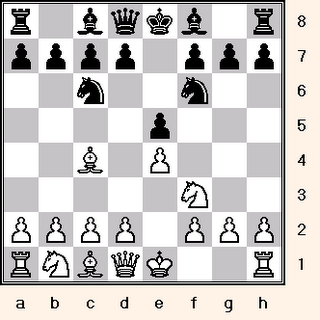
4 d4
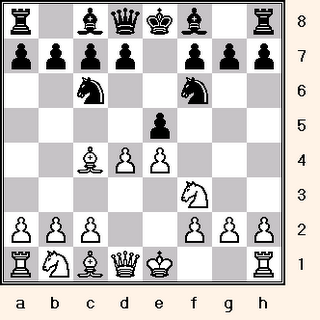
(i) Helps the c1 bishop to see the light
of day along the c1-h6 diagonal.
(ii) Assails e5 a second time. White asserts
himself in the center.
4 Ng5
4 d4 (Canal's Variation)
4 d3
4 Bb5
4 Nc3
4 O-O
4 Qe2
4 c3
4 ... exd4

Resolving the e5 tension and inaugurating
the Max Lange Attack.
4 ... d6
4 ... Nxe4
4 ... Nxd4
5 O-O

White temporarily gives up the d4 pawn in
order to achieve rapid mobilization.
Other options are:
5 e5 d5 6 Bb5 Ne4 7 Nxd4 Bd7.
5 Ng5 Ne5 6 Qxd4 (6 Bb3 gives
Black a slight advantage following 6 ... h6
7 f4 hxg5 8 fxe5 Nxe4 9 Qxd4 Nc5) 6 ... Nxc4
7 Qxc4 d5 8 exd5 Qxd5, with equality.
5 e5
5 Ng5
5 Nxd4
5 c3
5 Qe2
5 Bg5
5 ... Bc5

Protects d4 a second time.
5 ... Nxe4
5 ... Be7
5 ... d6
5 ... d5
6 e5

Gaining space plus also attacking f6.
6 c3
6 Nbd2
6 ... d5
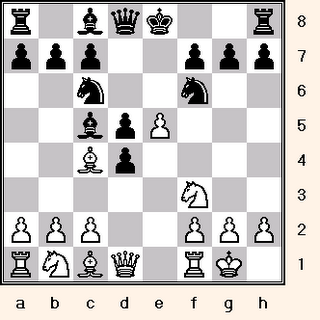
Black strikes back with an assault on c4.
The logic is if the f6 knight goes, then
the c4 bishop goes too.
6 ... Ng4? 7 Bf4 O-O 8 h3.
6 ... Ng4
6 ... Ne4
6 ... Ng8
7 exf6
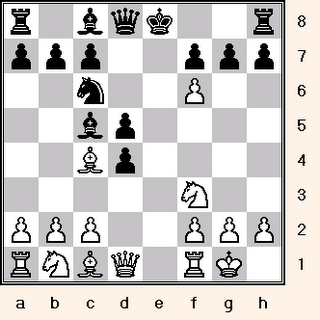
7 Bb5
7 exd6
7 ... dxc4
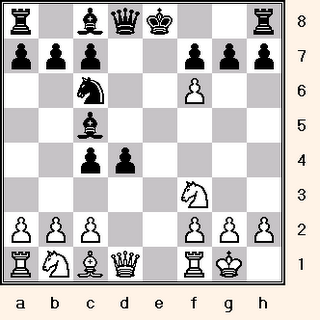
8 Re1+
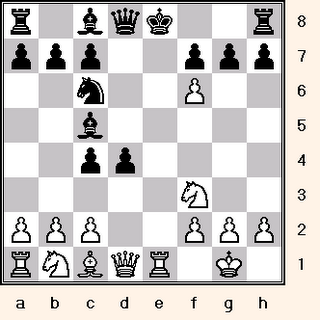
Taking advantage of Black's centralized King.
Not 8 fxg7? Rg8 9 Bg5 Be7 10 Bxe7 Kxe7!
(10 ... Qxe7? 11 Nxd4) 11 Re1+ Be6, and Black
is looking good.
8 fxg7
8 Qe2+
8 ... Be6

8 ... Kf8
9 Ng5
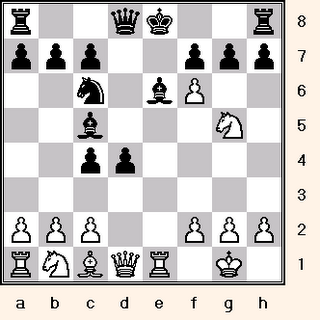
Threatening e6 a second time.
9 fxg7
9 ... Qd5
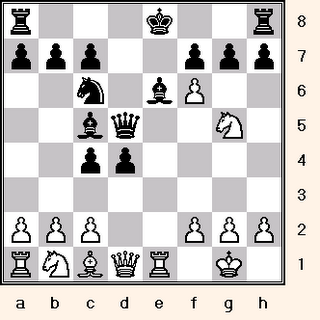
(i) Protects e6 a second time.
(ii) Makes way for queenside castling.
White wins the c5 bishop after 9 ... Qxf6??
10 Nxe6 fxe6 11 Qh5+.
9 ... Bf8
9 ... Qd6
9 ... Qd7
9 ... g6
9 ... Qxf6
10 Nc3
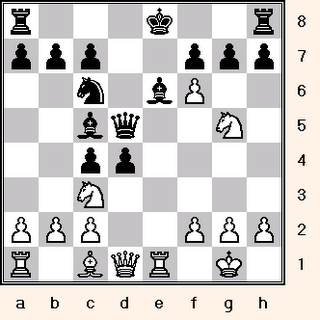
The knight takes aim at Black's Queen.
10 fxg7
10 Nxe5
10 ... Qf5
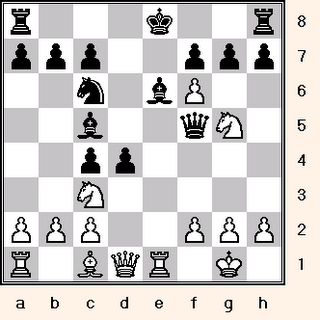
It's important for the Queen to not lose
sight of e6 otherwise White will play
Nxe6 followed by Rxe6.
10 ... dxc3? 11 Qxd5.
10 ... Qd7
10 ... Qd8
11 Nce4
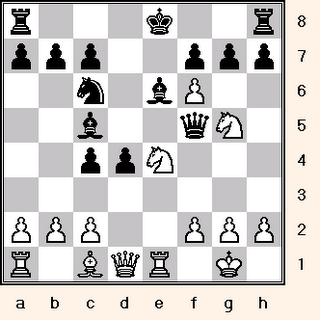
Or else 11 ... dxc3.
Black is better following 11 g4 Qg6 12 Nxe6 fxe6
13 Rxe6+ Kd7 14 Nd5 Rhe8 (14 ... Kxe6? 15 Nf4+).
11 g4
11 Nxe6
11 fxg7
11 ... O-O-O
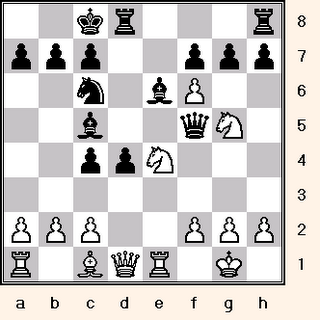
Finally, the King is secure.
11 ... Bf8
11 ... gxf6
11 ... Bd6
11 ... Bb6
12 g4
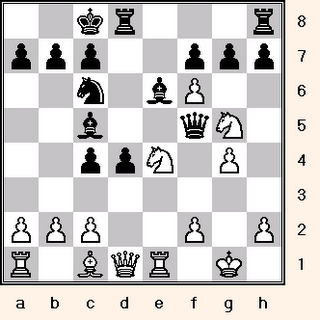
White takes another swipe at the Queen.
12 fxg7 Rhg8 13 Nxe6 fxe6
14 Bh6 Bb6.
12 Nxe6
12 Nxc5
12 fxg7
12 ... Qe5
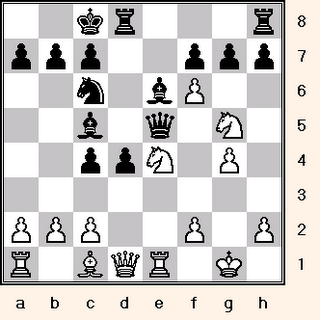
Again, she cannot lose sight of e6, or c5
for that matter.
12 ... Qd5 is inadvisable on account of
13 fxg7 Rhg8 14 Nf6.
12 ... Qd5
12 ... Qg6
13 Nxe6
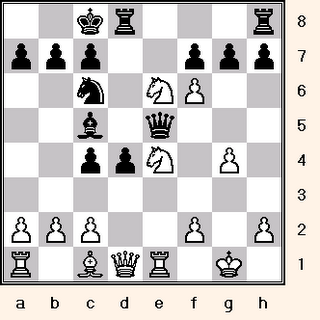
The position is unclear after: 13 Nf3 Qd5
14 fxg7 Rhg8 15 Nf6 Qd6.
13 f4
13 Nf3
13 fxg7
13 ... fxe6
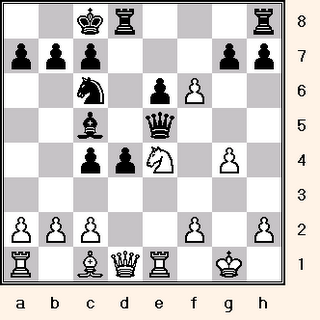
13 ... Qxe6
14 fxg7

Regaining the pawn lost on move four (4 ... exd4)
14 Bg5
14 ... Rhg8

14 ... Rhe8
15 Bh6

Shielding g7 from 15 ... Rxg7.
15 f4
15 Bg5
15 ... d3

(i) Gains central space.
(ii) Opens up the a1-h8 and g1-a7 diagonals
for the Queen and c5 bishop respectively.
15 ... Bb4
15 ... Rge8
15 ... Rde8
16 c3

Limits the Black Queen's scope along a1-g8
and also denies Black's pieces access to d4.
Not 16 cxd3? Rxd3.
16 cxd3
16 Nxc5
16 ... d2
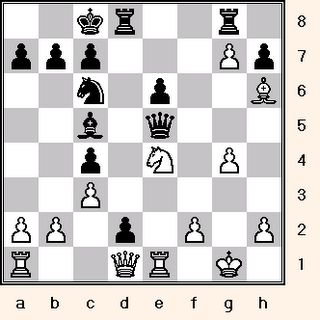
Gaining more space and also threatening
the e1 rook.
16 ... Be7
16 ... Bd6
17 Re2

17 Bxd2
17 Nxd2
17 ... Rd3
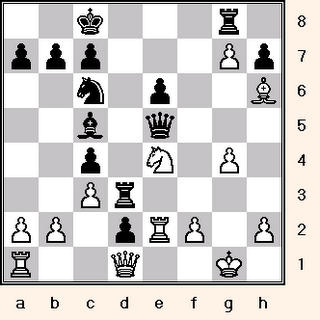
17 ... Bb6
17 ... Be7
18 Nxc5

18 Qf1
18 Ng5
18 Kg2
18 ... Qxc5

19 Rxe6

19 Rxd2
19 b4
19 ... Ne5

By ChessCoach@care2.com
6 e5 d5 7 exf6 dxc4 8 Re1+ Be6 9 Ng5 Qd5
10 Nc3 Qf5 11 Nce4 O-O-O 12 g4 Qe5
13 Nxe6 fxe6 14 fxg7 Rhg8 15 Bh6 d3
16 c3 d2 17 Re2 Rd3 18 Nxc5 Qxc5
19 Rxe6 Ne5 (Max Lange Attack)

Also available:
Chess: Understanding the Giuoco Piano
(Two Knights) Part I
http://chesscoach1950.blogspot.com/2006/01/chess-understanding-giuoco-piano-two.html
Chess: Understanding the Giuoco Piano
(Two Knights) Part III
http://chesscoach1950.blogspot.com/2006/08/chess-understanding-giuoco-piano-two_13.html
For explanations of moves 1 through 3
please refer to:
Chess: Understanding the Giuoco Piano
(Two Knights) Part I
http://chesscoach1950.blogspot.com/2006/01/chess-understanding-giuoco-piano-two.html
1 e4 e5 2 Nf3 Nc6 3 Bc4 Nf6

4 d4

(i) Helps the c1 bishop to see the light
of day along the c1-h6 diagonal.
(ii) Assails e5 a second time. White asserts
himself in the center.
4 Ng5
4 d4 (Canal's Variation)
4 d3
4 Bb5
4 Nc3
4 O-O
4 Qe2
4 c3
4 ... exd4

Resolving the e5 tension and inaugurating
the Max Lange Attack.
4 ... d6
4 ... Nxe4
4 ... Nxd4
5 O-O

White temporarily gives up the d4 pawn in
order to achieve rapid mobilization.
Other options are:
5 e5 d5 6 Bb5 Ne4 7 Nxd4 Bd7.
5 Ng5 Ne5 6 Qxd4 (6 Bb3 gives
Black a slight advantage following 6 ... h6
7 f4 hxg5 8 fxe5 Nxe4 9 Qxd4 Nc5) 6 ... Nxc4
7 Qxc4 d5 8 exd5 Qxd5, with equality.
5 e5
5 Ng5
5 Nxd4
5 c3
5 Qe2
5 Bg5
5 ... Bc5

Protects d4 a second time.
5 ... Nxe4
5 ... Be7
5 ... d6
5 ... d5
6 e5

Gaining space plus also attacking f6.
6 c3
6 Nbd2
6 ... d5

Black strikes back with an assault on c4.
The logic is if the f6 knight goes, then
the c4 bishop goes too.
6 ... Ng4? 7 Bf4 O-O 8 h3.
6 ... Ng4
6 ... Ne4
6 ... Ng8
7 exf6

7 Bb5
7 exd6
7 ... dxc4

8 Re1+

Taking advantage of Black's centralized King.
Not 8 fxg7? Rg8 9 Bg5 Be7 10 Bxe7 Kxe7!
(10 ... Qxe7? 11 Nxd4) 11 Re1+ Be6, and Black
is looking good.
8 fxg7
8 Qe2+
8 ... Be6

8 ... Kf8
9 Ng5

Threatening e6 a second time.
9 fxg7
9 ... Qd5

(i) Protects e6 a second time.
(ii) Makes way for queenside castling.
White wins the c5 bishop after 9 ... Qxf6??
10 Nxe6 fxe6 11 Qh5+.
9 ... Bf8
9 ... Qd6
9 ... Qd7
9 ... g6
9 ... Qxf6
10 Nc3

The knight takes aim at Black's Queen.
10 fxg7
10 Nxe5
10 ... Qf5

It's important for the Queen to not lose
sight of e6 otherwise White will play
Nxe6 followed by Rxe6.
10 ... dxc3? 11 Qxd5.
10 ... Qd7
10 ... Qd8
11 Nce4

Or else 11 ... dxc3.
Black is better following 11 g4 Qg6 12 Nxe6 fxe6
13 Rxe6+ Kd7 14 Nd5 Rhe8 (14 ... Kxe6? 15 Nf4+).
11 g4
11 Nxe6
11 fxg7
11 ... O-O-O

Finally, the King is secure.
11 ... Bf8
11 ... gxf6
11 ... Bd6
11 ... Bb6
12 g4

White takes another swipe at the Queen.
12 fxg7 Rhg8 13 Nxe6 fxe6
14 Bh6 Bb6.
12 Nxe6
12 Nxc5
12 fxg7
12 ... Qe5

Again, she cannot lose sight of e6, or c5
for that matter.
12 ... Qd5 is inadvisable on account of
13 fxg7 Rhg8 14 Nf6.
12 ... Qd5
12 ... Qg6
13 Nxe6

The position is unclear after: 13 Nf3 Qd5
14 fxg7 Rhg8 15 Nf6 Qd6.
13 f4
13 Nf3
13 fxg7
13 ... fxe6

13 ... Qxe6
14 fxg7

Regaining the pawn lost on move four (4 ... exd4)
14 Bg5
14 ... Rhg8

14 ... Rhe8
15 Bh6

Shielding g7 from 15 ... Rxg7.
15 f4
15 Bg5
15 ... d3

(i) Gains central space.
(ii) Opens up the a1-h8 and g1-a7 diagonals
for the Queen and c5 bishop respectively.
15 ... Bb4
15 ... Rge8
15 ... Rde8
16 c3

Limits the Black Queen's scope along a1-g8
and also denies Black's pieces access to d4.
Not 16 cxd3? Rxd3.
16 cxd3
16 Nxc5
16 ... d2

Gaining more space and also threatening
the e1 rook.
16 ... Be7
16 ... Bd6
17 Re2

17 Bxd2
17 Nxd2
17 ... Rd3

17 ... Bb6
17 ... Be7
18 Nxc5

18 Qf1
18 Ng5
18 Kg2
18 ... Qxc5

19 Rxe6

19 Rxd2
19 b4
19 ... Ne5

By ChessCoach@care2.com

0 Comments:
Post a Comment
<< Home